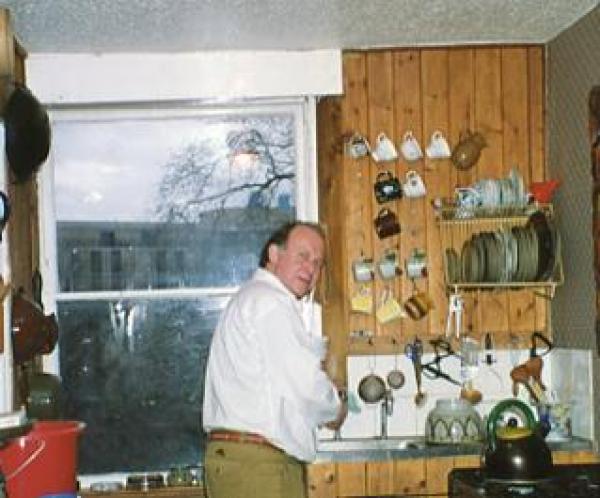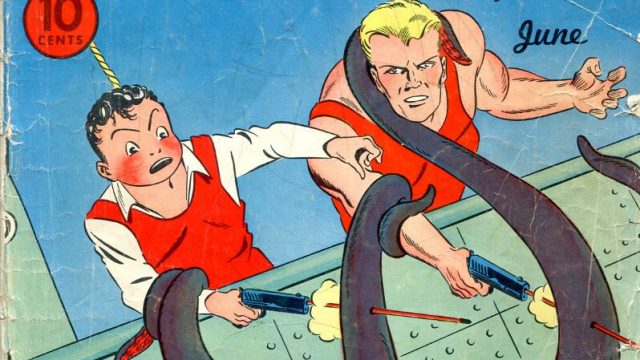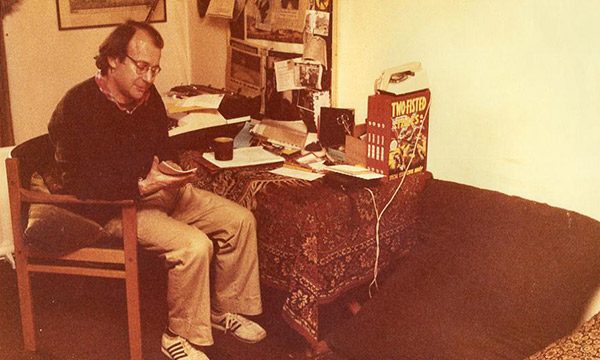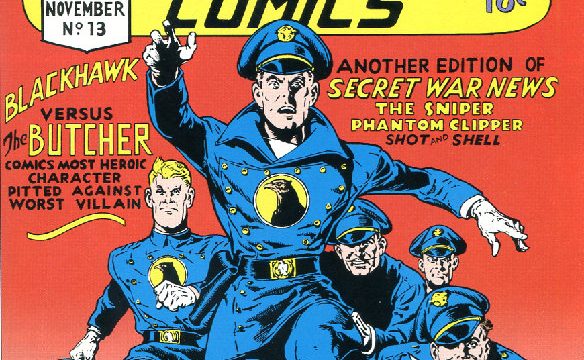It’s always miffed me slightly. So many females in my life had been derisory about my attachment to comics, except my fiancée Erica – we were together during my exile into the comic book wilderness. For five years I abstained; I didn’t read, buy or refer to comics. When Erica left me I despaired. Without her everything seemed pointless. I contemplated suicide. The breakup propelled me back into comics. I believe the comics saved my life.
From the start mom disliked me reading comics. She didn’t mind that my older brother read comics. He was unacceptably frenetic, too unmanageable to be moulded. There was always an uncomfortable chasm between my parents and Brian – being the middle child might have had a lot to do with it.
On the other hand mom’s comic book attitude might have been a gender thing. Maybe she reckoned that comics were a bad habit meant for boys. My older sister – a charming brain box – did not read comics. She read books and plenty of them. I devoured books, but that wasn’t enough for mom. There were few books in our household but there were scads of magazines and papers from America and from England – that meant a weekly infusion of comic strips. For it seemed that mom was trying to cover up the irrefutable fact that I was not the girl child she had wanted.
I get the shivers recalling those years before school. No matter what dad said, mom refused to cut my hair, dressed me in frilly clothes and fussed over my golden tresses. When neighbours complimented her on her pretty little girl, mom did not disavow them. Every time it happened I lit up like a pink light bulb. Anyway, it was impossible to argue with mom – my quirky, wonderful mother.
The female disapproval, opprobrium and disgust with comics did not end with mom. I could never forget the gutsy Xhosa princess and Miss South Africa beauty who stole my heart. I never tried to foist comics on her.

My Chelsea flat was small but like the humungous turtle in that Prince Ibis story, there were comics everywhere. The princess told me off; I had too many white friends and too many comic books. She eased up on whiteness but not on the comics.
Years later I went back to South Africa – after Mandela was released. Arriving at the family home on the slopes of Table Mountain I went down into the cellar with a torch. I was sure that when the comics ban was implemented I’d secretly saved some of the best ones, including Captain Marvel Adventures. I couldn’t find any.
Empty handed and disappointed I asked mom. I reminded her how she’d made me get rid of the comics. She told me I was talking nonsense. She had nothing to do with those comic books. I’d wanted to go to university and it was logical to get rid of the kid stuff. I dropped the matter. I’d come home to Welgemeend Street after decades in England to see my dying father. I had no intention of quarrelling with my mother.
Nonetheless, I wondered if I’d ever find that issue of Captain Marvel Adventures that plagued me. Was it really as I remembered it? Or was it a memory of something I wanted it to be. Inevitably I kept on searching for the missing Captain Marvel Adventures, never quite sure that it really existed outside my imagination.

In the 1970s things were different. I was still reading comics avidly but my career orientation was strictly the movies. I’d left Chelsea and migrated to the other side of Kensington – Holland Park. Nonetheless, I often went back to join the parade of swinging London along the Kings Road – especially on sunny Saturdays. That’s the where and how it began with the florid head turning Italian Fiorella B. With only a smattering of English it wasn’t surprising how she latched onto comics. Being Italian it had to be in the blood. The English got the novel and the Italians got the pictures, especially the ones that moved on the screen and on the page.
One of the finest items in The Rakoff Collection in the V&A is Guido Crepax’s The Magic Lantern. It’s a giant sized black and white 100 page comic printed on handmade Fabriano with each page protected by tissue paper. It’s a graphic tour de force S & M saga without words. It’s an artist’s book par excellence. The sequential narrative unfolds with an innocence that only a whimsical sexy Italian could conjure up.
Back to Fiorella B. The crowded pavement was spilling into the street. The traffic crawled giving way to the prettiest fashionable proletarian parade of flirtation and provocation imaginable. The constraints and prejudices, class, ethnicity and gender were not invited to the outdoor party. Long dresses, Tibetan amulets, African bracelets and sparkling adornments with flowers in their hair were commonplace and everywhere a whiff of marijuana.
Everyone was looking and so was I. There she was in a flowing crinkled white dress. Barefoot she crossed the road. Some might observe the chubby coquettish shape to be mini Rubenesque. Better still it could be from the strips of Roy Crane in the 1930s. The first adventure strip is attributed to Crane – Wash Tubbs – syndicated in the newspapers beginning in 1924. His women were chubby and bubbly and when they moved their feet danced above the ground rushing to escape another predatory male racing towards his inevitable comeuppance to be delivered by Captain Easy, who eventually got his own strip.
Chubby Fiorella B was as beautiful and as provocative as any of Roy Crane’s adventuress women. It was uncanny but there she was off the page. What was Fiorella really like and how could I get to meet someone like her?
An open top mauve Rolls Royce slowed to let Fiorella pass. Her disdain, her lofty disregard, was unimpeachable. If only she’d walk in my direction. She moved towards me and took the folded comic book from my side pocket. She held it as if she knew what a jewel it was. Turning some pages she said she loved comics. Maybe she said something else: I wasn’t sure what she said – semi coherent and remote as she was. I thought she was claiming ownership of the comic. She put the comic back in my pocket and held a spliff to my mouth. I took a puff, and she was off. A door on the mauve Rolls Royce opened. Taking her time Fiorella got in. I’d hoped she’d look back – she didn’t. The Rolls eased into the crowd. There she goes. I sighed. But it hardly mattered there in the heart of that swinging time. In those days very little seemed to matter. The world had become a much more hopeful place, especially in Chelsea.
Anyway, I was grateful not to have lost my comic to Fiorella. I’d been relishing an episode of Ogoth and Ugly Boot, serialised in the infamous Bloom publication Nasty Tales. It hardly mattered that Ogoth was not in colour, and English. It was compelling. Ogoth had imported the ambience of the American underground comic onto a retro science fiction post holocaust setting. It had verve and raciness. Ogoth had a raw vivacious line with legs stretched to accommodate elongated motorbikes. It eradicated gender barriers, class divisions, and race demarcations. It was witty and lively. I would’ve been sad to lose Ogoth even into the delicate hands of such an attractive creature.
Wearing impenetrable dark glasses Shura, working on the film of Gore Vidal’s Myra Breckenridge, passed by. She invited me to a party at her place, and joined the throng clinging to the mauve Rolls Royce. Shura looked back, and with a flamboyant wave.
It was a typical Kings Road Saturday – but I had to hurry home and finish reading Ogoth and Ugly Boot.
The next night I went to Shura’s trendy terraced house in Parsons Green.
In the middle of the open plan sitting room, ensconced in a Moroccan wicker chair, was Fiorella. On the floor close to her bare feet was a guy with a pony tail. The Pink Floyd was loud and the atmosphere heady. Fiorella was drawing. I moved around to see what her pencil was doing. She held up some explicit erotica. I laughed. She half turned and glanced up at me and then went back to her drawing. The ponytail guy tugged at her dress. She’d given no sign of recognizing me. I got swept away. Shura wanted me to meet some film people. When I left I tried to get Fiorella’s attention. I couldn’t.
About a fortnight later I was outside the National Film Theatre. The Italian accent called out – comics! Fiorella, half out of a car had her feet on the edge of the pavement and her dress pulled up over her thighs. She was buffing her nails and admiring herself in a mirror. She asked my phone number. I gave it to her. She wrote it on her hand. They drove off.
I was booked to see Last year at Marienbad. I’d seen it before. I had fantasized that I could learn French to get a job with the director Alain Resnais. In the art and design Graphis Magazine there was an article about how the mysterious Marienbad was based on Mandrake the Magician conceived by Lee Falk. Frames taken from the comic strip and the film placed side by side indicated the remarkable similarity. The layout of the garden maze, the elegant dress and the tuxedos were identical. Even the lugubrious star resembled Mandrake. There was some brouhaha when Marienbad had reached London in the early sixties. Having English subtitles probably enhanced the air of mystery surrounding the erotic fantasy that eschewed any easy answers. In a way it was akin to The Prisoner; the cult television series I worked on. Both obfuscated easy answers to the annoyance of audiences.
I was surprised but thrilled to hear from Fiorella B. She wanted me to bring her comics! Early the next morning I was at her ground floor flat in Pennard Mansions on Goldhawk Road in the heart of downtrodden Shepherds Bush. She was delighted with the comics I took her – a couple of Disney’s, probably Scrooge McDuck and Donald Duck, a few black and white Dick Tracy reprints, and Ogoth.
She let me in. I felt none of the warmth I’d anticipated. Had I got it all wrong? What was she up to? Were comic books all she wanted?
She had on a skimpy, diaphanous yellow nightshirt that hid nothing whatsoever. I forced myself not to stare. Why was she avoiding eye contact? I felt deeply uncomfortable.
After stumbling across the language barrier for half an hour, I thought I better move on. I couldn’t figure her out. All the time she’d been sitting on her low bed, fiddling with her fingernails and hunched over Donald Duck open flat in front of her. I was glad that she’d locked onto Donald Duck the supreme anarchist – written and drawn by the great master Carl Barks. Disney tried not to give Barks any credit whatsoever but in the end Walt was compelled to reveal who the incomparable Duck artist and writer was.
Fiorella was so engrossed in DD she didn’t notice me getting up but when I said I was going she insisted that I stay. She got up to put the kettle on. We sipped herb tea. She rolled a joint. She brushed against me. We kissed. I bent down to untie my sneaker laces.
The language divide became irrelevant. I stayed till dark. She intended moving in with me. She glanced at the bedside clock and told me I had to leave.
Outside the mansion block I glimpsed the ponytail chap getting out of his car. He couldn’t have seen me. I didn’t have her telephone number. She didn’t call and she didn’t move in with me.
It was a long time before she called. She wanted me to put up a Parisian medical student for a few nights. It was quite a while since my fleeting involvement with her. When nothing had come of anything I was left feeling that I had a narrow escape. Eventually it became evident that Fiorella B was trouble, which in no way diminished her allure. Nevertheless, I was apprehensive about her request. I told her to bring her Parisian friend round.

His teeth were clenched tight and he chain smoked those awful Gauloise. I gathered he was not an ex of Fiorella. He wasn’t an ex of any girl. He spoke with difficulty and exuded anxiety. It was a nervy struggle but he opened up. He suffered with constant girl frustration but he understood why girls didn’t fancy him. He was too uptight, he admitted. He wasn’t interested in reading comics but he was effusively grateful for my putting him up. He said I wasn’t like other friends of Fiorella.
A slender leggy posh English girl dropped in looking for my friend who wasn’t there. She stayed and stayed. I had an early call for the cutting rooms so I went off to bed leaving her slumped on the carpet with the Parisian drooling over her. She was poised over a Captain Easy. They spent the night together.
By the time the Parisian student left my place a few days later he was gushing over me. It was the high point of his visit to London. He kept in touch, offering me his flat in the middle of Paris.
It turned out that he spoke a lot about me to Michelle, a young girl from Marseilles. She wanted to meet me. He refused to give her my address. She slept with him to get a chance to steal my address and came to London.
I came home from the cutting rooms and there she was; Parisian chic, long shapely legs, pretty and another chain smoker. My flatmate had let her in. She had that lofty French snobbery. She wasn’t interested in comics. Superficially she wasn’t interested in anything. I was wrong on both counts.
Leaving my place at the end of her first visit she told me; it was not a question of if we would sleep together – just a matter of when. What an exit line. She was more film noir than comic strip. Though, maybe she was the Dragon Lady from Terry & the Pirates. Orson Welles wrote a fan letter to Caniff, creator of Terry. Welles must have seen how the villainous Dragon Lady resembled Rita Hayworth. Seemingly clean cut Michelle also had a dark side å la the Dragon Lady.
Michelle and I got involved. One evening I found her lying in the bath. She’d been there for ages. She was engrossed in the oversized EC horror reprint. I sat on the edge of the bath. She turned a page. My heart sank. It was the biggest and heaviest comic book I had. It was not easy to hold it up at anytime – and there it was dangerously close to the water, my special, precious EC volume.
(When the EC publisher appeared in front of the HUAC subcommittee on juvenile delinquency McCarthyism had a stranglehold on America. The publisher had argued that a cover depicting a severed head in the foreground with an axe in the background was not in poor taste. Had the severed neck been dripping with viscera and the axe moist with gore that would have been in poor taste, he argued. With that comment the axe of McCarthyism fell irrevocably. The wonderful, lurid EC ceased publication concluding The Golden Age of Comics. What Superman started in 1938 ended with EC in 1954.)
The EC reprint descended slightly. Michelle’s voice floated over the Vault of Horror towards me. She was not going to wet anything – she assured me. Another page turned – water splashed. It was hair-raising. I took the volume and Michelle got out of the bath. I pulled the plug. She gave me a whimsical glance. Her face creased up with laughter. She knew what she’d put me through.
Michelle never took another comic book into the bath. She’d sensed the edge of explosion simmering in my silence. She must have been conditioned to warfare. Her father was an armaments manufacturer – like Daddy Warbucks in Little Orphan Annie.
Michelle got an expensive flat on the edge of Mayfair. We flitted between her flat and my flat. One night she said I couldn’t stay. Once a fortnight she had to pay for the flat – in bed.
After three or four months Michelle went back to France. Ages later she came back but resuming the liaison was not possible. She became a Bunny Girl in the newly launched Penthouse Club in Park lane.

The female that entered my life and outlasted all the others, was the striking independent creative thinker Sue M. After working together with Lindsay Anderson on If…. Sue and I stayed friends. We socialized together everywhere. We became inseparable kindred spirits. We fought off the jobbers of the freelance cutting rooms side by side. It was an unusual intense friendship.
One weekend Michelle came down to Sue’s family home in Dorset. Everyone liked French Michelle. She was at her ease, straight and upbeat. Sue particularly liked her. Sue thought that was the girl for me to marry. Mind you the girl I did eventually marry Sue thoroughly approved of. But that comes later.
In many ways Sue and I were oddballs. Both of us were deeply attached to Lindsay. It goes without saying: Sue took to the comics more than anyone else of either gender. She took to one comic especially – Captain Marvel Adventures. Mainly drawn by CC Beck and scripted by Otto Binder which was and still is my favourite and most significant superhero. As a thirteen year old boy in apartheid South Africa I’d used a Captain Marvel story to extol subversion against racism to the school Civic Society.
CC Beck’s clear line, exquisite wit, and moral consciousness in Captain Marvel Adventures were exemplary. For thirty years I searched for that particular issue of Captain Marvel Adventures which I’d used in my schooldays. In the end my friend Paul G tracked it down and gave it to me as a birthday present. Thanks Paul.


